The rise of the submachine gun – the pistol-round firing automatic carbine – began around World War I, picked up in World War II, and arguably peaked for several decades subsequent to its technological zenith in the 50s and 60s after the invention of still-prolific systems like the Heckler and Koch MP5 and the UZI. Whether through correlation or causation, it seems that the use of the 9mm SMG platform has seen an inversive decline coinciding with the emergence of abbreviated rifle-round carbines such as the 5.56x45mm Colt Commando of the sixties and seventies (an AR15/M16 platform with a 10″ or 11.5″ barrel), the AK-74U of the late seventies, and their respective, still-reigning successors, the Mk18 CQBR and the AK-10x series, for example.
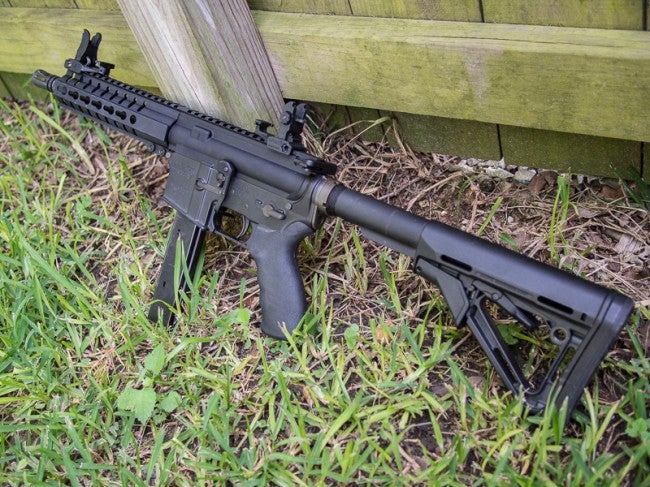
While it appears that military/police use of the SMG has declined sharply over the last thirty years, there are numerous advantages of the pistol-caliber carbine (hereafter “PCC”) that the rifle-chambered PDW or carbine cannot match: For one, the PCC’s less-concussive muzzle blast has numerous benefits:
(1) Reduced report makes the PCC easier to handle in indoor settings where a muzzle blast can be blinding or deafening (even with the proper hearing protection, many rifle-cal. SBRs generate a sinus-jostling shock, especially indoors), or in any situation where you don’t want to irritate nearby shooters or generally keep the noise level down. This also comes into play if one were to use the PCC for home defense, and desired a lower-penetrating and lighter-recoiling round that was still effective at close ranges and wouldn’t create a flashbang-ish muzzle blast when fired.
(2) Relatedly, the PCC is better for suppression/silencer use than a rifle caliber. Subsonic 9mm or .45ACP ammunition is much easier to find than subsonic .223 or .308, and much more prolific and less expensive than .300BLK. Moreover, something like the AAC Evo-9 is a lot lighter than a YHM Phantom 5.56/7.62, and can be easily interchanged from pistol to PCC.
(3) In addition to suppressor commonality, ammo and sometimes magazine commonality (
such as the Kel-Tec Sub-2000) between a pistol and a PCC has some economic and practical/tactical benefits.
There are numerous other benefits of the PCC which, in total, lead one to wonder why these platforms are not more popular. This articulation of the benefits of the PCC, however, should not be construed as a condemnation of the rifle-caliber PDW/SBR, which has some major advantages over the PCC. (I hope to post a review of my triangle-folder M92 Yugo in the near future to explore the benefits of a rifle-caliber carbine/PDW).
If you have read this far and agree that a PCC is worth investing in, then I am pleased to acquaint you with the subject of this review: CMMG’s new Mk9 AR-style series chambered in 9mm.
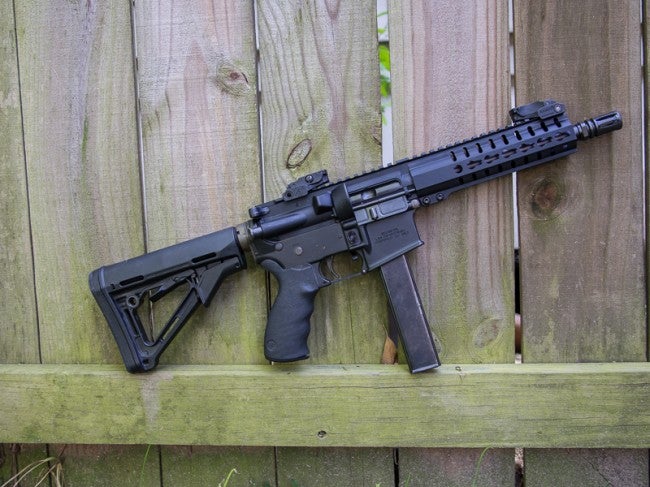
Specifications:
The Mk9 upper is made of forged 7075-T6 aluminum, and is chambered in 9mm, with a 9″ barrel made of nitrided 4140 chrome-moly steel in a 1:10″ twist. It is a simple, pure blowback operating system. Those who plan to use suppressors or muzzle devices on the Mk9 should be advised that the barrel is threaded in 1/2″-36 – this is the case with almost all 9mm AR-style carbines, perhaps due to the significant risk that a user might accidentally install a .223 muzzle device with 1/2″x28 threads onto a 9mm upper, which could be dangerous. Accordingly, if you plan to use a suppressor, you may have to obtain a thread adapter (I recommend a 1/2″x36 to tri-lug adapter, if you can locate it) or get a new piston/sleeve for your suppressor if it has interchangeable pistons (and be sure to install a fixed barrel adapter if your suppressor has a Nielsen device).
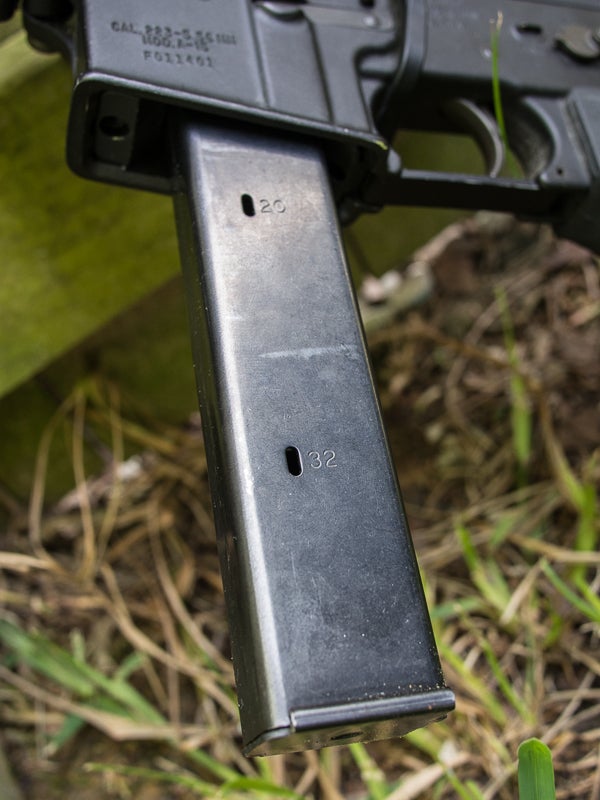
The CMMG Mk9 uses 32rd. Colt 9mm magazines.
The Mk9 comes with the excellent free-floating RKM7 KeyMod Handguard. I got a preview of the CMMG KeyMod Handguard series in my review of the
CMMG Mk3. For those unfamiliar with KeyMod,
KeyMod is a proposed replacement for the MIL-STD-1913 interface, sometimes referred to as “Picatinny rail.” In other words, KeyMod – the product of a VLTOR/Noveske collaboration – was designed to replace the traditional Picatinny rail system that has been found on most AR systems since the late nineties. KeyMod employs a keyhole-type system on the mounting surface (such as a rail) whereby accessories such as lights and lasers can be mounted without the use of tools if they have a KeyMod nut designed to fit in these “keyholes.” The primary benefit is reduced weight through eliminating un-utilized Picatinny rail interface (which extrudes from the mounting surfaces), and a more ergonomic surface as it is ‘toothless,’ unlike Picatinny rail. Dozens of manufacturers, including CMMG, have embraced this open-source technology, and it is taking the gun universe by storm at the moment. You can find more information on KeyMod here.
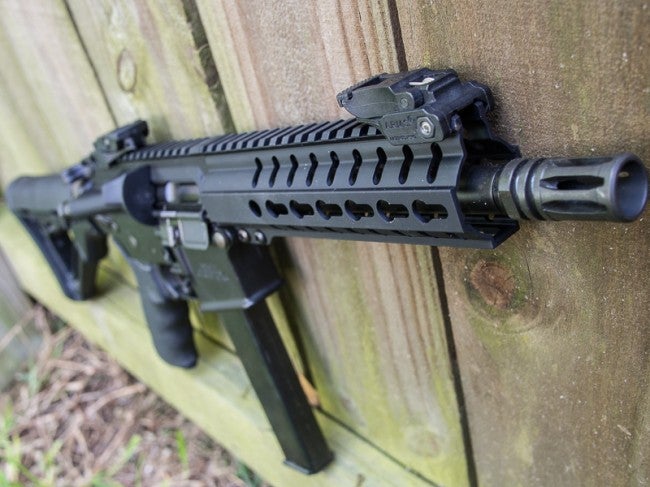
A closer look at CMMG’s RKM-7 KeyMod handguard.
The KeyMod slots on the RKM7 are located at the 3, 6 and 9 o’clock positions and allow users to mount compatible accessories directly to the hand guard. For accessories that are not yet compatible with the KeyMod system, CMMG offers separate 5-slot rails that attached to the hand guard. For mounting sights and optics, a 1913 Picatinny rail runs across the top of the firearm.
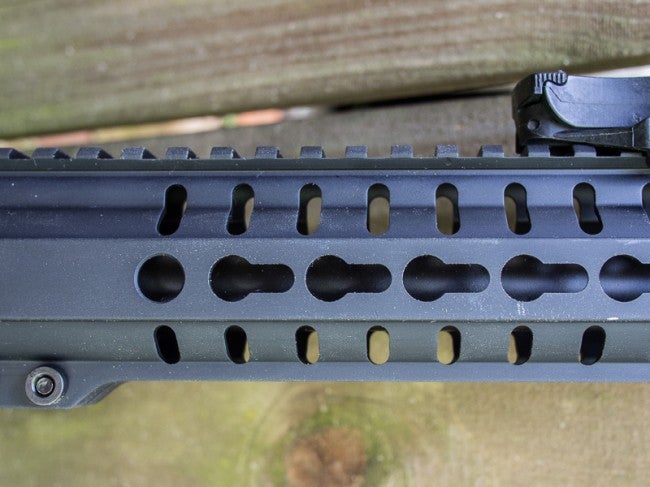
Another view of CMMG’s RKM-7 KeyMod handguard.
The receiver includes a 9mm bolt (which will be required for you to shoot on your AR). The Mk9 series of lower receivers have 9mm magazine-specific mag wells that look and function perfectly, however, note that if you plan to drop the Mk9 upper on a standard 5.56mm AR lower, you will need a 9mm buffer and a 9mm magwell adapter so the 32rd. Colt-pattern 9mm magazines will fit in your lower. There are numerous options on the market, however, I personally bought the Spike’s magwell adapter specifically for use in this review. It installs in maybe sixty seconds – put it in the magwell, tighten the tension screws, and you’re all set. Better still, it allows the use of your standard magazine release unlike some magwell adapters, which are actually held in place by your lower’s magazine release, and therefore, engaging the mag release might cause the entire adapter to drop out of the well. Note that you may also need a 9mm hammer for your kit to function properly.
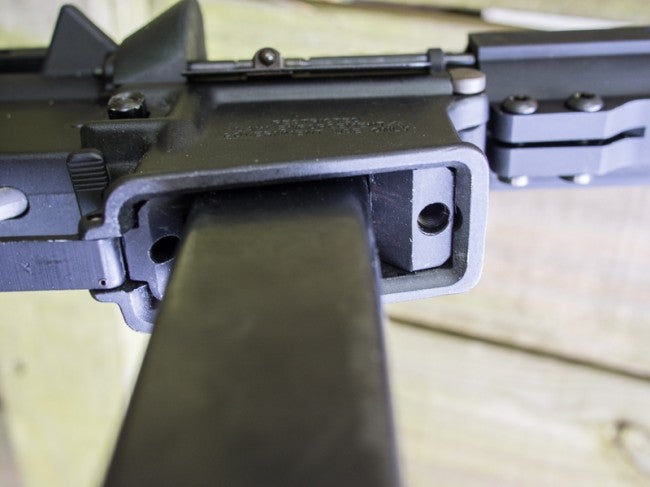
Closeup view of the Spike’s Tactical magwell adapter the author used for this review.
MSRP is $1,099.95 for the Mk9 PDW
Pistol – i.e., that price includes a full, functioning firearm/complete lower minus a buttstock. While, as I will discuss later in this review, I don’t favor the AR pistol configuration, I see the platform’s stock going up rapidly due to the recent ATF opinion letter
wherein the ATF took the position that shouldering the SIG Pistol Brace was completely legal. Accordingly, many readers would probably consider buying the pistol, complete, and then adding the brace versus going through the requirements, expense, and wait for an SBR stamp.
The pistol has a single-stage mil-spec type trigger and weighs 5.3 lbs. with an O.A.L. of 24 inches. It comes equipped with a Magpul MOE pistol grip, and an ambidextrous loop-style sling attachment point in front of the castle nut.

The pistol setup includes an ambi sling plate and MOE grip, as pictured.
The complete upper weighs only 3.3lbs and has an MSRP of $749.95.
The pistol and upper come with the “CMMG Lifetime Quality Guarantee.”
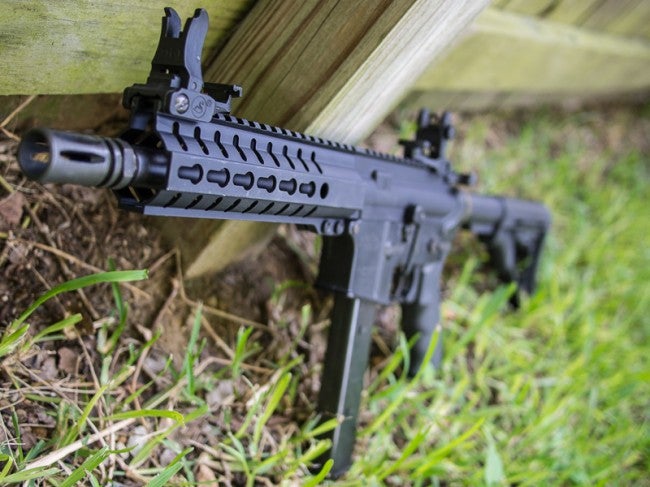
General Observations and Range Evaluation:
I took the CMMG Mk9 pistol to the range along with my SBR lower. As stated, the lower was fitted with the Spike’s Tactical mag block, which worked perfectly throughout the session. Myself and some beginner shooters put the Mk9 through its paces at 25 and 50 meters, firing over 400 rounds of mixed CCI Blazer 147gr (which has a flat nose), 124gr M882 U.S. issue ball rounds, and even some Federal 9BPLE +P+ hollow point. No malfunctions occurred whatsoever, which is doubly impressive considering that I did not clean or lube the upper or BCG of this evaluation gun prior to shooting it.
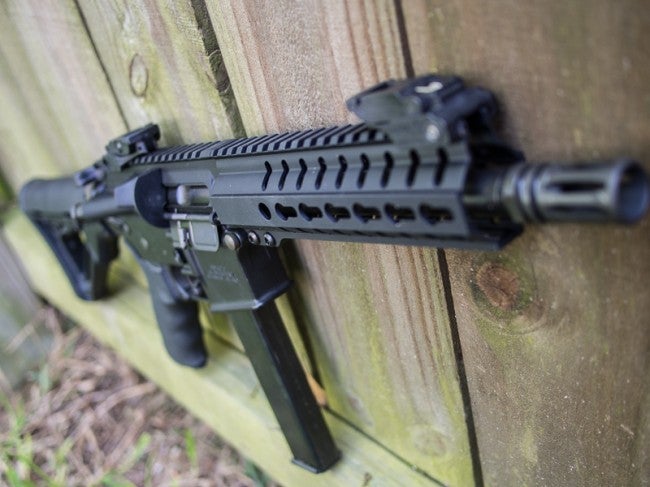
The Mk9 upper on the author’s SBR lower.
The trigger is a standard GI single stage, and is thus very familiar to the AR owner. Recoil and muzzle blast were virtually non-existent with the mild (but effective) 9mm round. All the safety, bolt release/ping pong paddle, trigger, and magazine release functioned crisply. While the bolt hold open only held open after the last round about half the time on my SBR lower, it functioned 100% of the time when equipped on CMMG’s Mk9 pistol lower. Without further evaluation, I would conclude that maybe my BAD lever or the Spike’s magblock could have caused some interference, or maybe I just need to replace my BHO assembly after years of use and thousands of rounds through my pre-2004 Becker, MN D.P.M.S. lower
The gun was reliable and straightforward in use, with the same manual of arms as the standard AR. Fit and finish were superb, just as with the CMMG Mk3 I reviewed last month.
As to accuracy: Using A.R.M.S. 71L flip-up sights that I provided, even the newest shooters of the bunch could hit 8″ steel plates at 25m with almost no effort and just a few seconds of advice on sight alignment. One of the novice shooters was so impressed with the light recoil and his accuracy results with the Mk9 versus his bedside 9mm pistol that he asked me numerous times during the session where he could find one for use as a home defense carbine.
These results held true out to 50m. As I was sighting in the A.R.M.S. 71Ls, I shot a five round group that was only about one and a quarter inches wide, spoiled by a flyer. Four of the rounds were actually in a group just about three quarters of an inch wide. These were extraordinary results, and I could not replicate them for the rest of the session with iron sights (I was shooting from a seated rest with the handguard on an ammo can). That said, the accuracy from the Mk9 was excellent. Using a 1x electronic optic like an AIMPoint or EOTech would work very well on the Mk9.
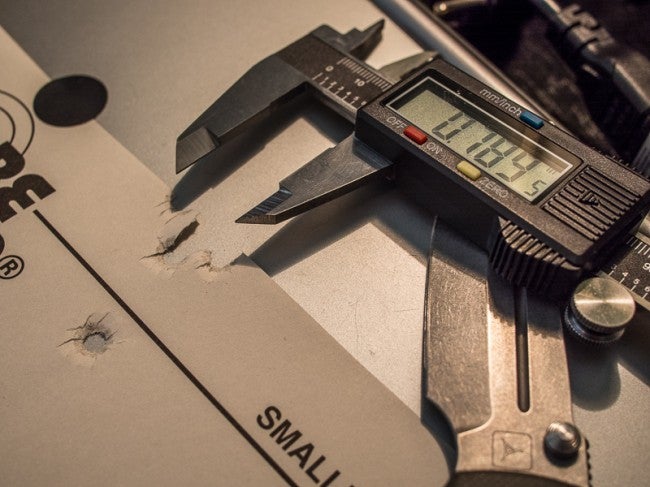
Four of the first five rounds fired with iron sights from the MK9 at 50m landed in a group that was about three-quarters of an inch wide.

The first five round 50m group from the Mk9 was approximately 1.3 inches wide. This was with iron sights and from a seated rest.
Magazine changes were simple enough. The mag would drop free from the CMMG lower with the forged magazine well, but did not readily drop free from my SBR lower/mag block combo. Non-drop free mags are not uncommon in the PCC field, however – note that the UZI has a paddle release at the base of its pistol grip and the venerated MP5 uses a paddle mag release as well. On the other hand, inserting a magazine with more than a handful of rounds in it was difficult on a closed bolt, so I’d make sure your BHO works if you plan to use your own lower instead of one of CMMG’s Mk9 lowers.
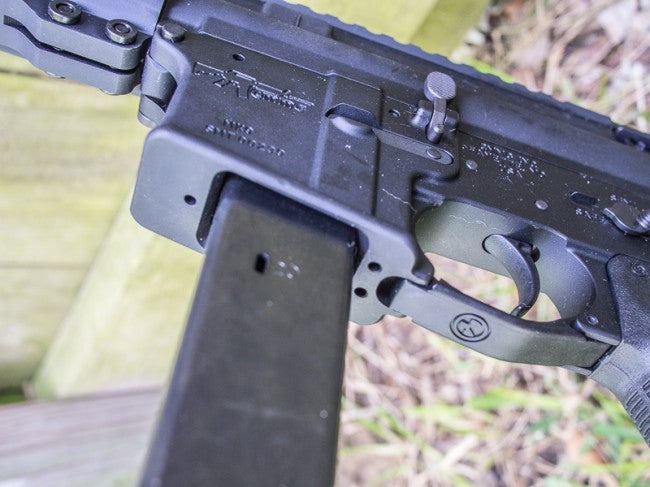
A view of the forged magazine well built into the Mk9 lower. This is typically much more reliable and functional than using an adapter, although less versatile.
Handling was excellent. The SBR Mk9 felt sleek and balanced, and definitely has a high-speed, low-drag look. Between the reliability, handling, ergonomics, and accuracy, I was impressed with the Mk9 in an SBR configuration.
You may be able to see that the ear of the rear sight (the left ear in this picture, i.e. right ear if you are looking down the sights from behind the gun) from the ARMS 71 polymer BUIS broke during the photo shoot. The Mk9 fell over while leaned against the fence – maybe a foot of travel – and landed on the sight. The ear broke clean from the sight, and I set the ear back in place to finish the session. This is pretty disappointing for a high-end manufacturer like ARMS.
As to the pistol configuration, I was less impressed. Note that this is a byproduct inherent in the AR-pistol design generally, not any issue with CMMG’s Mk9 pistol. I have found shooting an AR pistol to be awkward, barely more accurate than my beater 226, if at all. I managed (but did not measure) decent accuracy shooting the CMMG in pistol configuration at 25m, although it was awkward. As a tip, using the larger aperture in any peep sights is a good idea when shooting as a pistol.

The Mk9 in pistol configuration.
I employed a tactic that I have heard lends itself to greater accuracy in using a pistol AR – sling tension. Using a single point Marom Dolphin ‘bungee’ sling, and forcing the pistol forward, it seemed that stability and thus, accuracy, improved. While the Marom Dolphin is an excellent single point by any measure, however, I can only surmise that a more tense material like a nylon or Cordura sling would be better for those purposes.
That said, not many readers will likely purchase and retain the Mk9 in pistol format; many of you will almost certainly SBR this lower or use a SIG pistol brace, as is now more popular subsequent to a favorable ATF opinion letter allowing the practice of shouldering the brace.
Negative observations:
With the rifle in SBR configuration, I had almost no complaints. While the difficulty in inserting loaded 32rd. Colt magazines on a closed bolt was a minor bugbear, I am sure that this is unrelated to CMMG’s particular product and is more or less incidental to the platform or the Colt magazine setup. Other than that, I had no issues whatsoever with this particular setup.
As stated, it was not nearly as easy to shoot the Mk9 in pistol format as with a stock, but again, this is more or less a byproduct of the AR pistol generally, not an issue with CMMG’s product.
Conclusion:
In conclusion, shooters’ options are limited these days for a good, out of the box 9mm PDW/SMG-type platform. Some of the older options are dated and/or expensive, such as the MP5 or UZI, which are not nearly as modular as the AR platform while costing hundreds or thousands more for a reputable or original manufacture. Additionally, other PCC options usually require a shooter to do the SBR paperwork before taking ownership, or to SBR the carbine and then chop the barrel, which adds to the expense.
Fortunately, CMMG’s Mk9 is a very good option for shooters looking for an SBR 9mm (note that the Mk9 also comes in a 16″ variant as well). The evaluation of the Mk9 showed that it was accurate, reliable, and well-made. Additionally, the $749 MSRP makes it accessible for shooters who already have AR15s and want to expand into 9mm. (Note that you may need a mag well adapter, 9mm buffer, and 9mm hammer for a 9mm upper to work on your 5.56/.223 lower.) I highly recommend this upper.
In all, the pistol caliber carbine may not shine as brightly as the more modern rifle-caliber carbines and PDWs, and that is unfortunate, as available options like the CMMG Mk9 offer a bevy of advantages over their more powerful AR brethren. If you have the opportunity to shoot a 9mm upper, take it, and then give the CMMG Mk9 your attention when you decide to add a 9mm AR to your collection.









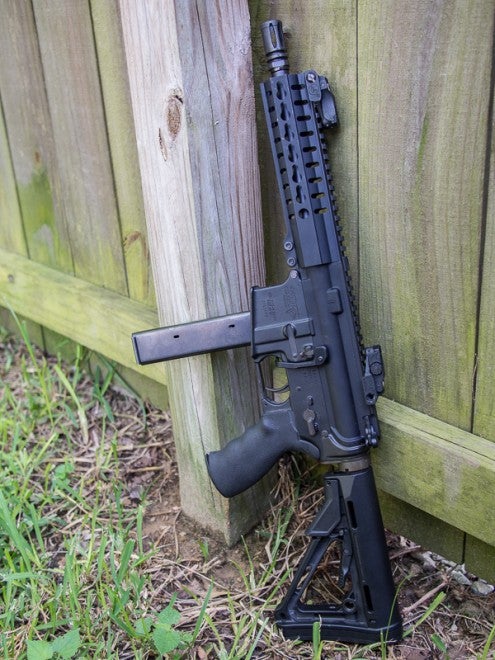




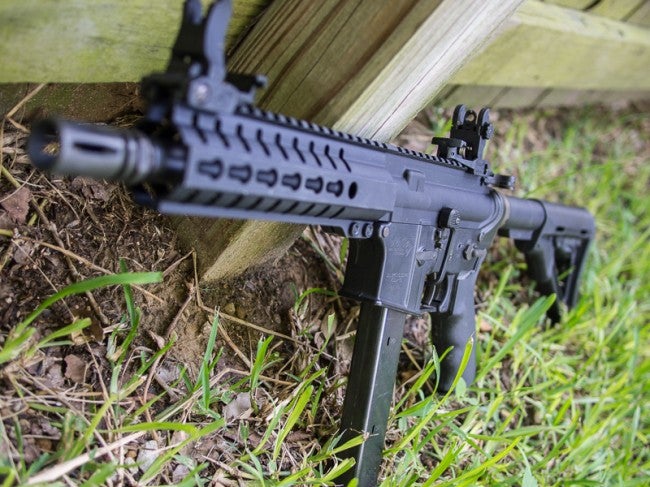
 Your Privacy Choices
Your Privacy Choices
